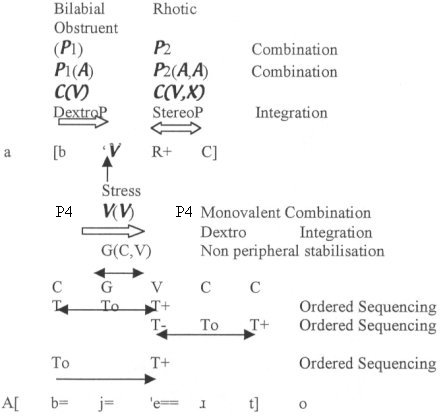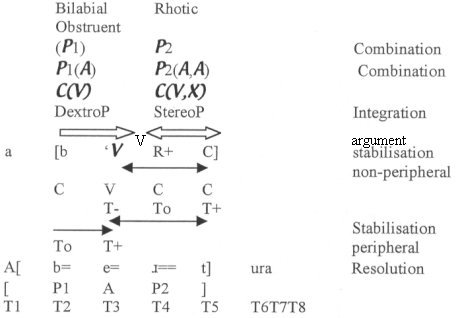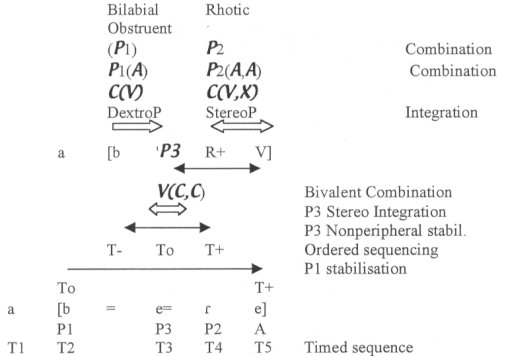
5.4.3 Integration
In order to describe the Spanish svarabhakti construction from a perceptual point of view, I will focus on regulatory mechanisms which control expansion and compression effects. To be more precise in defining these mechanisms, I will suggest that Predicates can be classified with respect to the way in which they can integrate with their arguments.
| (17) | Integration of P |
 |
This three way integration when articulated motorly may create meaning. If the element which has this plastic integration is a phonological element, say rhoticity, then it may create three meanings. Such varied integration correlates with three different meanings in Spanish: ba[ra] "metal bar", v[aRa] "twig" b[a®] "bar" (García-Bellido 2003).1
I will suggest that the Integration of a phonological element can be different from its Stabilisation. This can be illustrated with two examples taken from Spanish Phonology.
| (18) | Dextro integration of Voiced Palatal Vocoid / Levo Integration of Rhoticity2 |
  |
The morpheme "bar" has a Consonantoid-Rhotic with a Monovalent Combination, a Levo integration and two stabilisations: Non-peripheral and Peripheral. I will refer to a plasticity in stabilisation which integrates a following element from a non simultaneous syntactic unit: as "extra-connective" to name the case here of Levo integration with non-peripheral stabilisation stabilising with a following V taken from an external source from where the Rhoticity is. The Rhotic in (5) has a bivalent combination and a stereo integration. This explains why this morpheme has obligatory post-rhoticity epenthesis, since once Rhoticity is set to stereo integration, it cannot stabilise as peripheral.
Levo Glides in Spanish are peripheral and non-extra-connective since they integrate only with the preceding V of
its simultaneous syntactic unit.3 Dextro-glides in Spanish are non peripheral and stabilise with a
preceding Consonantal Argument in its simultaneous syntactic unit intra-morphemically: a[
 je]r+to
"open" or extra-morphemically va[l+je+]ndo "Costing" (García-Bellido 2000,2003). The stabilisation of a Dextro glide can be
achieved through an epenthetic Argument process in the sequencing. This occurs, if stress interacts with an undifferentiated
accented Vocoid, 'V. This epenthetic stabilisation process can be exemplified with the morpheme "open" in Spanish for (7v).
je]r+to
"open" or extra-morphemically va[l+je+]ndo "Costing" (García-Bellido 2000,2003). The stabilisation of a Dextro glide can be
achieved through an epenthetic Argument process in the sequencing. This occurs, if stress interacts with an undifferentiated
accented Vocoid, 'V. This epenthetic stabilisation process can be exemplified with the morpheme "open" in Spanish for (7v).
| (19) | Castilian "open" |
 |
When the morphological combination VR+C, which introduces in the sequence a C from the following morpheme, does not supply a source for the agreement or binding of the Place of Articulation of the Argument of the Rhoticity, then the Vocoid Argument of the rhoticity is defined as an accentable Vocoid, 'V. This accented Vocoid P4 is plastic. If stress interacts with it, the accented vocoid is expressed as a monovalent combination with a dextro integration and a non-peripheral stabilization. If a Consonant is in the environment of P4, the non simultaneous sequencing of the Predicate P4 stabilises with this C preceding it. P4 stabilises with an epenthetic V following (see 14a,b). The epenthetic Vowel is resolved if the elements back, high, low and round are switched off: [e]. The Glide is resolved if the element high is switched on but the elements low, back and round are switched off: [j]. The Rhotic is resolved in Castilian if the element lax and tense are switch off: [e ® t].
A different chain of events unfolds if stress does not interact with the accented Vocoid (7iv).
| (20) | Castilian "open" |
 |
When the base integrates with a morpheme which contains a Vocoid (7i) the chain of events is yet different from (19) and (20) for the phonological resolution of the same morpheme "open" in Spanish.
| (21) | Castilian "open" |
 |
An undifferentiated unaccentable Vocoid-Predicate via the stereo integration of the Rhotic with the Vocoid of the following morpheme, establishes a bivalent Predication with stereo integration and an ordered stabilisation of Obstruent preceding and liquid following.
1 Meaning will be used here in a non precise way. If some utterance (motorly produced) functions in social interaction, then it has a meaning.
2 In standard Phonological approaches, PostV-peripheral C is called Coda and PreV-peripheral C, Onset (Van der Hulst & Riter 1999). However, non-peripheral P, which can be subject to deletion under identity with both Vs, the precedent and the following, cannot be represented in an autosegmental theory (Khan 1976, Shein and Steriade 1986). This problem is discussed and resolved within a selective combinatorial approach in García-Bellido (2000, 2003).
3 The fact that the Sibilant (S) can integrate with a levo Glide is a
special property of the Spanish sibilant which is hyperstretchable when in Levo integration compared to its less stretchability
when in Dextro integration. VGS [sejs] "six"; VLS [bals] "Walz", VNS [ ens] "Yen+pl",VOS arg[ots] "argot+pl";
*SLV *SNV *SOV (García-Bellido 2004) .
ens] "Yen+pl",VOS arg[ots] "argot+pl";
*SLV *SNV *SOV (García-Bellido 2004) .
Volumen 22 (2005) ISSN: 1139-8736 |